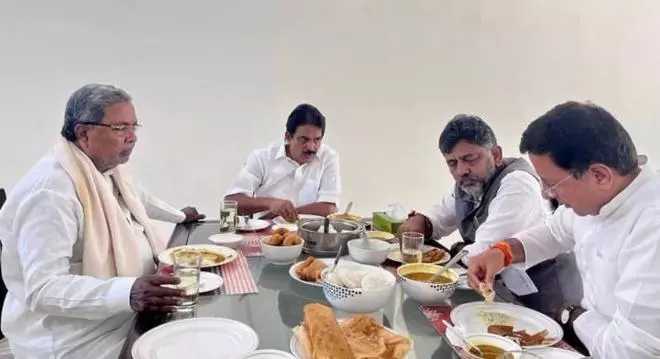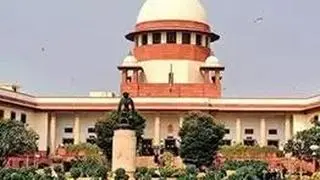The year was 2004. After serving a near full five-year term, the Congress party under S. M. Krishna went to the polls again. But in a major reversal, the Grand Old Party (GoP) crashed to a mere 65 seats from the 132 it held in the previous assembly. A rising BJP managed to bag 79 seats and former PM Deve Gowda’s Janata Dal (Secular) got 58 in the 224-member assembly. However, to keep the BJP out of power, the Congress was happy to tie up with the JDS.
But a wily Deve Gowda was wary of making the ambitious and able Siddaramiah, the CM. So, Dharam Singh headed the coalition. It took two full days to convince a sulking Siddaramiah to accept the Deputy CM’s post. Siddaramiah or Siddu as he is referred to in Karnataka, saw the writing on the wall. The JDS would never allow anybody except a member of the Gowda family to rise to the highest echelons.

Congress president Mallikarjun Kharge with Karnataka’s newly announced Chief Minister Siddaramaiah and Deputy CM D.K. Shivakumar at the Special Congress party briefing at AICC HQ by KC Venugopal, General Secretary (Org.)

Congress president Mallikarjun Kharge with Karnataka’s newly announced Chief Minister Siddaramaiah and Deputy CM D.K. Shivakumar at the Special Congress party briefing at AICC HQ by KC Venugopal, General Secretary (Org.)

Special Congress party briefing at AICC HQ by KC Venugopal, General Secretary (Org.)
Caste compulsions
Right from 1983, when he first entered the portals of the Vidhana Soudha, the seat of power in Bengaluru, riding a surprise victory from the rural Chamundeshwari constituency on a Lok Dal ticket, Siddu had always fought on an anti-Congress platform. The Lok Dal, though, was a non-existent party in the state and Siddu, who had won on his own strength, decided to join the Janata Party. Subsequently, serving in various avatars of the Janata Parivar – first the Janata Party, then the Janata Dal , and finally the Janata Dal Secular – the pugnacious lawyer built his politics around opposing the Congress’s ideology.
His aggressive championing of the use of Kannada language in administration and ability to connect with people in a rustic manner, endeared him to the then CM Ramakrishna Hegde, who made him minister for animal husbandry and veterinary services in 1985. However, Siddu realised quickly that caste matrix mattered in state politics.
Siddaramiah, a Kuruba (traditional Shepherd caste), the third largest grouping in the state, accounting for 11 per cent of the population, after the Lingayats (17 per cent) and Vokkaligas (14 per cent), joined hands with Deve Gowda, then a rising Vokkaliga leader, in opposing the Lingayat-Brahmin lobby. Hegde, though a Brahmin, was backed by the powerful and numerically dominant Lingayat leaders.
It did not help that in his third election, his opponent was M Rajashekar Murthy, a tall Lingayat leader and a veteran Congressman. The upstart Siddaramaiah, who had by then handled diverse portfolios such as Sericulture, Animal Husbandry and Transport, was defeated from Chamundeshwari constituency that had elected him twice before. It was his friendship with Deve Gowda, which helped him survive politically. He was named General Secretary of the Janata Dal, which had morphed from the Janata Party, in 1992.
A near miss
Riding on an anti-Congress wave, Siddu returned to the assembly and was made the finance minister in Deve Gowda’s cabinet. When Gowda moved to the Centre to become PM in 1996, Siddu was hoping to become the CM, but was outmanoeuvred by the powerful Lingayat lobby, which made J H Patel, one of their own, the CM, and he had to be satisfied with the Dy CM’s post. Three years later, after increasing friction with Patel and the Hegde faction in the party, Siddu chose to side with Deve Gowda’s faction.
The internecine war within the Janata family did have a cost though. Siddaramiah again lost from Chamundeshwari constitutency. He was back in the political wilderness. But after the Patel-Hegde Janata Dal (United) faction merged with the BJP, Gowda and Siddu deftly steered the JDS, which emerged as the third pole in the state in 2004.
With Gowda ensuring that he missed out on the CM’s chair in 2004, a seething Siddaramiah was eventually expelled from JDS. That is when he decided to build a broader social coalition AHINDA – a Kannada acronym for minorities, backward classes and Dalits – to counter the two numerically dominant castes, the Lingayats and Vokkaligas, and joined his one-time nemesis, the Congress, to extract revenge against the Gowda family.
- Read: The last of the Mohicans
Near political deaths
Twice in his nearly five-decade-long political career, Siddu has faced an existential crisis. In the 2006 by-election he contested from Chamundeshwari after quitting the JDS, the then CM, H D Kumaraswamy - Deve Gowda’s son - personally led a campaign to defeat Siddu, along with his then Deputy CM, B S Yediyurappa of the BJP.
Ironically, the political strategist who helped him counter the Vokkaliga might of the Gowdas, was another Vokkaliga leader, D K Shivakumar of the Congress, who is now his arch-rival. Siddu prevailed by a mere 257 votes, that too after multiple rounds of vote-checking.
The halo of withstanding the might of the Gowda family in their stronghold of Old Mysuru helped him emerge as a state-wide leader in his own right. In the 2008 assembly polls, chary of the machinations of the Gowda family, he shifted to neighbouring Varuna constituency and won.
Similarly in 2018, after serving a full five-year term as CM – only the second Karnataka CM to do so – he returned to Chamundeshwari, having vacated Varuna for his second son Yatindra. However, on receiving intelligence reports that G T Deve Gowda, an old friend-turned-foe contesting on a JDS ticket, had the upper hand, , he contested from a second seat, Badami in Northern Karantaka, where the Kuruba community is in the majority.
As predicted, the sitting CM suffered a humiliating loss in the Chamundi seat, and barely won Badami by 1,696 votes in the final round of counting. Siddu had managed to survive to fight another day.
Luck, LoP and CM chair
In 2008, when the BJP came to power on its own for the first time in Karnataka, Congress veteran Mallikarjuna Kharge, now party President, became the leader of the Opposition. However, when the Central leadership moved Kharge to the Centre and inducted him into the Manmohan Singh Cabinet, luck smiled on Siddaramiah and, in spite of being a new entrant to the Congress, was elevated as leader of the Opposition.
In the 2013 polls, when the BJP committed hara-kiri following a split in the party – Yediyurappa walked out to form the KJP following numerous corruption allegations – the Congress swept to power under KPCC President Dr G Parameshwara, a party loyalist and Dalit leader. However, again, as luck would have it, while the Congress stormed back to power, Parameshwaram himself lost in his Kortagere constitutency and, thus, Siddu became Congress CM of Karnataka less than seven years after joining the party.
With an absolute majority, Siddu consolidated his hold on the administration, party, as well as his AHINDA coalition. His term was known for the numerous ‘Bhagya’s schemes, which were primarily freebies for the poorer sections of society. In spite of being accused of minority (Muslim) appeasement and some corruption charges, Siddu stuck to his guns and built a good rapport with Rahul Gandhi.
When a Modi wave helped the BJP emerge as the single largest party in 2018, he swallowed his pride to allow a JDS-Congress coalition to take power, with his old bete-noire Kumaraswamy at the helm. When the coalition collapsed 20-months later, Siddaramiah again seized the initiative to regain control of the party.
In 2023, to play safe, he had his son vacate the Varuna seat, which he has won handsomely. Incidentally, his old Chamundeshwari seat, was again won by JDS.
Private life
Siddaramiah is married to Parvathi and has two sons Rakesh and Yatindra. Rakesh, the elder son, was seen as his political heir, as he managed the affairs of his father’s constituency and acted as his election agent. However, the colourful Rakesh, who had a liking for movies and the fast life, died young at the age of 38 in 2016, due to multi-organ failure.
17-year-old Dhavan, Rakesh’s son, however, campaigned with his grandfather, Siddaramiah, in the recent polls. He has expressed political ambitions, even as his uncle Yatindra, a clinical pharmacist by training, who vacated the Varuna seat for his father, may be inducted into the Upper House.
Siddaramiah has on multiple occasions lashed out against idolatory, the caste system and even questioned the date of birth of Lord Hanuman. Fond of non-veg food, he has hit out against organisations which have targeted him for visiting a temple immediately after consuming fish. Unlike in the past when he used to declare himself to be an atheist, Siddaramiah has clarified that he is ‘more of a spiritual person and not an atheist’ and occasionally visits temples and participates in village temple dances. He also enjoys playing chess with his grandchildren.
Challenges ahead
With the Congress having made numerous promises of doles and freebies, including 200 units of free electricity to all BPL families, free travel for women in buses, unemployment doles and Rs 3,000 per month for the woman head of every BPL family, Siddaramiah will have his hands full.
Pushing development beyond the capital Bengaluru, completing irrigation projects, improving infrastructure, and generating jobs are some of the other challenges. However, having presented a record 13 budgets as state finance minister, the 75-year-old Siddaramiah knows his numbers.










Comments
Comments have to be in English, and in full sentences. They cannot be abusive or personal. Please abide by our community guidelines for posting your comments.
We have migrated to a new commenting platform. If you are already a registered user of TheHindu Businessline and logged in, you may continue to engage with our articles. If you do not have an account please register and login to post comments. Users can access their older comments by logging into their accounts on Vuukle.